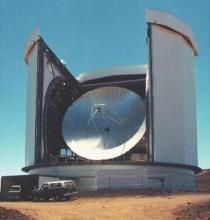-
About the Project
- The James Clerk Maxwell Telescope is the world's largest dedicated submillimetre telescope and is located at the summit of Mauna Kea, Hawaii. It has pioneered imaging and spectroscopy in the submillimetre wavebands.
Cavendish AP Group involvement
- The group is actively involved in the development of detectors, receivers and techniques for astronomy at millimetre and sub-millimetre wavelengths.
- Recent projects include the 16-detector 350GHz receiver HARP for the James Clerk Maxwell Telescope in Hawaii, and the development of 183GHz water vapour radiometers for ALMA.
- The HARP array receiver enables the kinematics of molecular gases in regions of star formation and in nearby galaxies to be determined. The process of star formation is one of the great problem areas of astronomy and has far reaching consequences for the origin and evolution of galaxies.
HARP-B
- HARP is the Heterodyne Array Receiver Programme for the James Clerk Maxwell Telescope. The programme began with HARP-B, a 16-element Heterodyne Array Receiver to operate at B-band (325-375 GHz).
- The HARP-B project was a collaboration between Cavendish Astrophysics (MRAO) at the University of Cambridge, UK, The Joint Astronomy Centre at Hilo in Hawaii (operators of the JCMT), The UK Astronomy Technology Centre at the Royal Observatory Edinburgh, The Herzberg Institute of Astrophysics of the National Research Council Canada.

